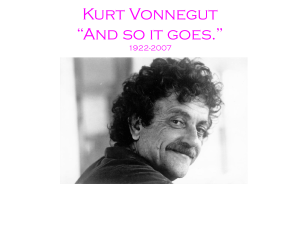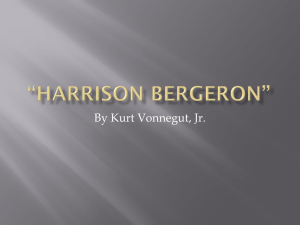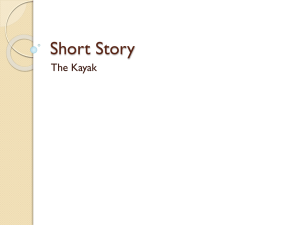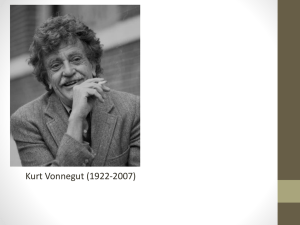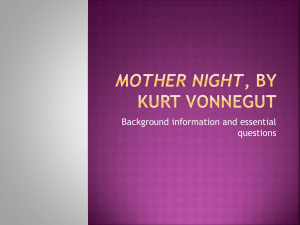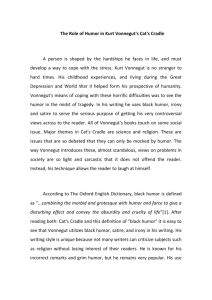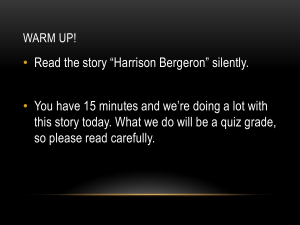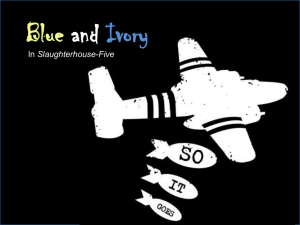Sarah Spicer - English Honors Program
advertisement
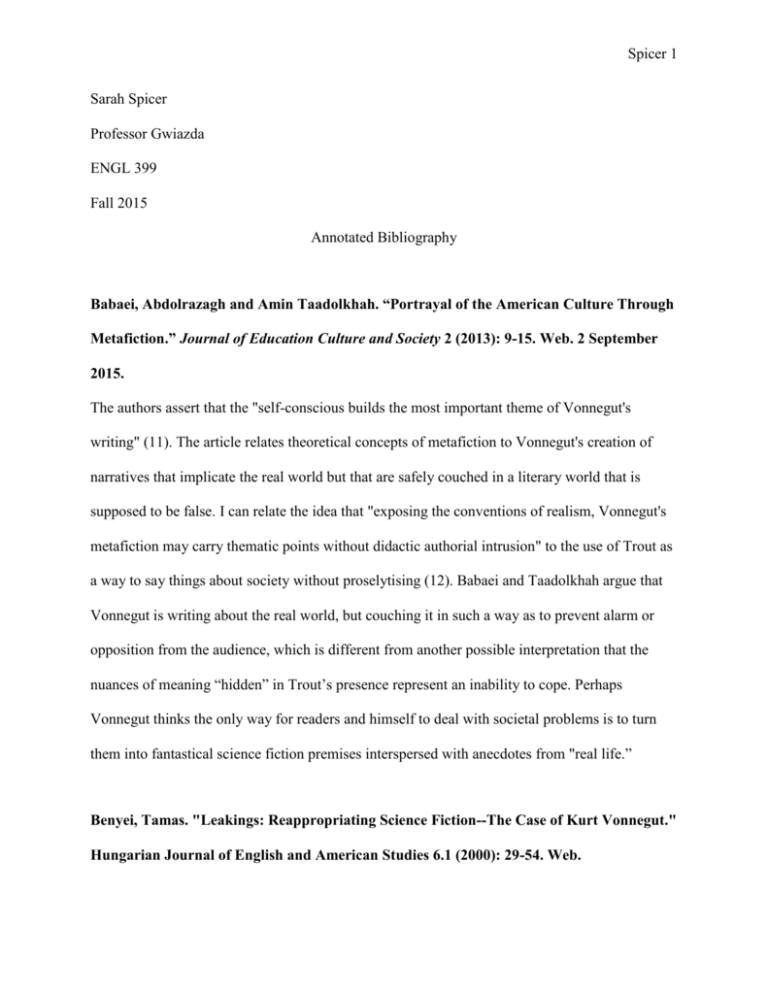
Spicer 1 Sarah Spicer Professor Gwiazda ENGL 399 Fall 2015 Annotated Bibliography Babaei, Abdolrazagh and Amin Taadolkhah. “Portrayal of the American Culture Through Metafiction.” Journal of Education Culture and Society 2 (2013): 9-15. Web. 2 September 2015. The authors assert that the "self-conscious builds the most important theme of Vonnegut's writing" (11). The article relates theoretical concepts of metafiction to Vonnegut's creation of narratives that implicate the real world but that are safely couched in a literary world that is supposed to be false. I can relate the idea that "exposing the conventions of realism, Vonnegut's metafiction may carry thematic points without didactic authorial intrusion" to the use of Trout as a way to say things about society without proselytising (12). Babaei and Taadolkhah argue that Vonnegut is writing about the real world, but couching it in such a way as to prevent alarm or opposition from the audience, which is different from another possible interpretation that the nuances of meaning “hidden” in Trout’s presence represent an inability to cope. Perhaps Vonnegut thinks the only way for readers and himself to deal with societal problems is to turn them into fantastical science fiction premises interspersed with anecdotes from "real life.” Benyei, Tamas. "Leakings: Reappropriating Science Fiction--The Case of Kurt Vonnegut." Hungarian Journal of English and American Studies 6.1 (2000): 29-54. Web. Spicer 2 Benyei discusses the opposition between pulp science fiction and literary science fiction, and how Trout embodies both of these conceptions of the genre. Vonnegut's inclusion of Trout and his stories denotes his "awareness of the problem as well as his double or duplicitous position regarding it" (31). Benyei elaborates on what he calls the "interfaces between serious literature and science fiction" and on how Vonnegut's texts comment on those interfaces (32). These interfaces include: science fiction as the most adequate way to express contemporary reality, science fiction and fantasy as realist at their core, and the creation of a science fiction elite/canon. For Benyei, it is important to explore Vonnegut's use of science fiction even though he does not want to be classed as a science fiction writer. I can use Benyei's idea that "science fiction may be said to be one discourse in the polyglossic textual universe of the novel," and that Trout's stories are encyclopedic, to explore how Trout's stories create additional layers of ambivalent meaning throughout Vonnegut's works (38). Berryman, Charles. "Vonnegut's Comic Persona in Breakfast of Champions." Modern Critical Views: Kurt Vonnegut. Ed. Harold Bloom. Philadelphia: Chelsea House Publishers, 2000. 63-71. Print. Berryman focuses on Vonnegut as a self-inserted character in Breakfast of Champions, and on how this character becomes separated from Vonnegut the author and ends up parodying authoraudience interactions. Kilgore Trout functions as one layer of this parody, as a vision of an unappreciated and unfulfilled author. The idea that Vonnegut as the author is separate from Vonnegut as the narrator is one that I plan to explore in my paper, as is the way that Trout adds to the exploration into authorship. Berryman’s comments on Trout can help me both with a discussion of Vonnegut and Trout’s similarities, but also with a discussion of how Vonnegut’s themes are transmitted to Trout and his works. Spicer 3 Broer, Lawrence R. "Images of the Shaman in the Works of Kurt Vonnegut." Modern Critical Views: Kurt Vonnegut. Ed. Harold Bloom. Philadelphia: Chelsea House Publishers, 2000. 101-110. Print. Broer counters the notion that Vonnegut is an author who ultimately displays despair for the human condition, rather arguing that Vonnegut functions as a shaman figure, unveiling the ills of society and providing suggestions for how to deal with, or at least cope with them. I agree with Broer’s more hopeful image of Vonnegut and his philosophy, and my view of Trout as a prophet in a way mirrors Broer’s view of Vonnegut as a shaman. Trout thus becomes a mouthpiece for Vonnegut’s shamanistic suggestions for society. Broer views Trout as a scapegoat rather than as a prophet, but either way, he is often the voice of Vonnegut’s more damning ideas about society. Broer, Lawrence R. "Vonnegut's Goodbye: Kurt Senior, Hemingway, and Kilgore Trout." At Millennium's End: New Essays on the Work of Kurt Vonnegut. Ed. Kevin Alexander Boon. New York: State University of New York Press, 2001. 65-90. Print. Broer compares Vonnegut and Hemingway's careers in this essay, looking at their similarities but also at Vonnegut's disapproval of Hemingway. This argument contains a section on Trout as one of the ways that Vonnegut "purge[s] himself of his more embittered and cynical self" (Broer 77). Trout starts out with this cynical characterization, but in later novels (Timequake) he has become "Vonnegut's shaman" – a force of potential healing rather than disillusionment. It will be important for me to also examine Trout's narrative trajectory over the course of the four novels that I am studying, to see how his "alternative realities" change in terms of content and privilege, and this essay could be a valuable resource in elaborating on those changes (Broer 82). Spicer 4 Gholson, Bill. "Narrative, Self, and Morality in the Writing of Kurt Vonnegut." At Millennium's End: New Essays on the Work of Kurt Vonnegut. Ed. Kevin Alexander Boon. New York: State University of New York Press, 2001. 135-147. Print. Gholson's essay focuses on Vonnegut's moral positioning and how he articulates issues of morality when "there is no Truth or metadiscourses to access outside of human-made languages and contexts" (135). His answer to that issue is that narrative itself "can transform the self," so it is crucial to view self as a form of narrative in Vonnegut's works (136). These issues of self, narrative, and morality are undoubtedly present in Trout himself, and although Gholson does not discuss Trout at length, I can broaden the ideas of artistic creation, articulation, narrative, and audience to contain Trout as well as Vonnegut. Trout forms another layer of this conversation that is absent in Gholson's essay. Greer, Creed. “Kurt Vonnegut and the Character of Words.” The Journal of Narrative Technique 19.3 (1989): 312-330. JSTOR. Web. 2 September 2015. Greer focuses on Vonnegut as an indistinct character who is made un-real by his inclusion as a narrator in Breakfast of Champions. He says that the novel "is inscribed with a textual schizophrenia that makes problematic [Vonnegut’s] claim of authorship and the association of the author and narrator in general" (312). Greer argues that even though Vonnegut attempts to be both "the author" of the book and "an author" within the book, in the end the two identities cannot mesh. Greed says that "Every time you try to settle the problem of who is real, the problem itself becomes unsettled because the terms that define the problem become indistinct" (315). The article compares Breakfast of Champions and Now It Can Be Told as two stories containing similar elements in which there is a question of who has free will. He also focuses on the importance of comparing characters between Vonnegut's texts, because of how they jump Spicer 5 between the boundaries of the texts. In terms of Trout, Greer points out that when Vonnegut frees Trout at the end of the novel, he "is released from the responsibility of representation. He is no longer simply a character in a book who represents the real world. The real world and the fictional are no longer separate categories" (320). Greer also examines the Farmer book Venus on The Half-Shell, which was originally published under the pseudonym Kilgore Trout; however, this does not function in my examination of the role of Trout within Vonnegut's novels. Hume, Kathryn. “The Heraclitean Cosmos of Kurt Vonnegut.” Papers on Language & Literature 18.2 (1982): 208-224. EBSCO. Web. 2 September 2015. Hume argues that Vonnegut's "cosmos" of works consists of many of the same themes, places, and characters, but also contains a sense of flux that means that any Vonnegut work must be examined in relation to other Vonnegut works in order to glean the fullest meaning from any one work. She says that these mutations "shape his most striking literary techniques, they help explain his plots and his favorite anthropological issues, and they provide the terms for him to express some of his basic philosophical beliefs" (209). Hume goes into many of the strategies that Vonnegut uses to establish the necessity of his works being read intertextually. More relevant to my research, Hume adds that the many reiterations of characters throughout Vonnegut's novels "represent complex attempts to make sense of the elements in human nature which puzzle Vonnegut," and specifically says of Kilgore Trout that he is used to explore "problems that affect [Vonnegut] as an artist, and those problems shift throughout his life” (213) Even though this is an incomplete picture of Trout's role in my view, Hume's idea of "Trout as a metaphor" whose "changes are not realistic and novelistic, but symbolic" is definitely one that I should engage (214). Spicer 6 Hume, Kathryn. "Vonnegut's Self-Projections: Symbolic Characters and Symbolic Fiction." The Journal of Narrative Technique 12.3 (1982): 177-190. Web. This article discusses how Vonnegut uses his recurring characters to express "parts of his psyche, and they let him work out his inner conflicts" (177). These characters function more as allegories than as characters, and these symbolic qualities are important to explore to be able to grasp Vonnegut's works fully. Hume's discussion of Trout focuses on his multiple roles, but regardless of the role he functions to symbolize various aspects of Vonnegut's ideas about society. Even though I would like to focus a bit on Trout as a character, looking at Trout as a symbolic projection will also be important in parsing out his functions. Klinkowitz, Jerome. The Vonnegut Effect. Columbia: University of South Carolina Press, 2004. Print. In this book, Klinkowitz chronologically discusses how Vonnegut was able to create works that were ingeniously postmodern while also being strikingly American in their cultural commentary and appeal. He considers Vonnegut to be a bricoleur, using any materials he had at hand to create meaning within his works. Kilgore Trout is one of these “materials” that Vonnegut used in several of his novels to add layered meanings to his central themes. Klinkowitz’s discussions of the individual novels that I am studying will be useful for me because of his focus on how Vonnegut’s thematic and structural considerations interplayed. Lerate de Castro, Jesús. “The Narrative Function of Kilgore Trout and His Fictional Works in Slaughterhouse-Five.” Revista Alicantina de Estudios Ingleses 7 (1994): 115-122. Web. 2 September 2015. Spicer 7 This article looks at how the interspersing of texts, specifically Trout texts, within Slaughterhouse-Five highlight specific themes present in the novel. It goes through each of the six Trout stories/novels within Slaughterhouse-Five and what themes they illustrate. This may be a potential strategy I can use, but regardless, the ideas that Lerate de Castro posits about the functions of the stories themselves will be useful for my purposes. Lerate de Castro also characterizes Trout as a "prophetic voice," which is a function I have come to notice as well in my reading of Trout in Vonnegut's novels (125). McCammack, Brian. “A Fading Old Left Vision: Gospel-Inspired Socialism in Vonnegut’s Rosewater. The Midwest Quarterly 49.2 (2008): 161-178. Web. 2 September 2015. McCammack explores God Bless You, Mr. Rosewater as a foray into the potentials of "the individual, private sphere aspects of social humanitarianism rather than mass, public-sphere manifestations" (162). Vonnegut's humanism-socialism blend concerns the realm of the personal. McCammack argues that each of Vonnegut's prescriptions for humanity is a "private-sphere solution to public-sphere ills" (169). This intense focus on the individual and on the implications of character actions on other people can factor into a discussion of Trout, because his books often have profound effects on other characters. McCammack also discusses Trout as an "alter ego" for Vonnegut, which is a commonly held view in the literature. Although I agree with that view, I also think it will be important for me to point out how this "alter ego" is imbued with ambivalence and instability through Trout's characterization in the novels. Merrill, Robert. Vonnegut’s Breakfast of Champions: The Conversion of Heliogabalus. Critique: Studies in Contemporary Fiction 18.3 (1977): 99-109. EBSCO. Web. 2 September 2015. Spicer 8 Merrill discusses how Vonnegut creates himself as a "literary construct," in Breakfast of Champions, and how that confuses his autobiographical inclusions, as well as how Vonnegut's views bleed over into other parts of the text (101). Merrill argues that Dwayne Hoover and Kilgore Trout are both facets of Vonnegut's personality/opinion in an intellectual debate with each other. Present in this discussion are detailed descriptions of some of the similarities between Trout and Vonnegut. Merill also includes brief summaries of the "morals" of Trout's parable-like tales. His description of Trout as "an unappreciated prophet, almost literally unread...gradually lost faith in the possibilities of reform, finally becoming a rather frightening misanthrope" is a great summary of the character in Breakfast of Champions. Reed, Peter J. and Marc Leeds, eds. The Vonnegut Chronicles: Interviews and Essays. Westport: Greenwood Press, 1996. Print. This book is a compendium of three interviews with Vonnegut, eleven essays on Vonnegut, and a selected bibliography of works about Vonnegut. The interviews included will be helpful for informing how Vonnegut viewed his own work and constructed his writing with an audience in mind. The essays I plan on using (Reed’s “The Responsive Shaman: Kurt Vonnegut and His World” and Rackstraw’s “Dancing with the Muse in Vonnegut’s Later Novels”) all look at Vonnegut’s work in retrospect and attempt to evaluate it according to modes of thought that had been previously unexplored. Reed’s assertion that Vonnegut is a shaman-like figure who attempts to heal his audiences through his writing can be transposed partially onto Trout’s role as well. Rackshaw details how Vonnegut uses language metafictionally reveal binary oppositions as counterintuitive ways to organize reality. Spicer 9 Reed, Peter. "Writer as Character: Kilgore Trout." Bloom's Modern Critical Views: Kurt Vonnegut. Ed. Harold Bloom. New York: Chelsea House Publishers, 2008. Web. Reed's essay explores the various functions that Trout has within Vonnegut's works. He says that Trout is a way for Vonnegut to explore his social commentary in a broader sense, as "an alternative voice through which Vonnegut can find the freedom to be an iconoclastic as he pleases" (114). Reed focuses specifically on Trout as a writer whose voice parallels and empowers Vonnegut without making Vonnegut's opinions seem didactic. Although this article is very similar to what I what to write about, it does not necessarily focus on Trout as a character, or the problematic/ambivalent aspects of Trout's role (for example, his role as a science fiction writer when compared to Vonnegut's views of science fiction). Simpson, Josh. “‘This Promising of Great Secrets’: Literature, Ideas, and the (Re)Invention of Reality in Kurt Vonnegut’s God Bless You, Mr. Rosewater, Slaughterhouse-Five, and Breakfast of Champions,” or, “‘Fantasies of an Impossibly Hospitable World’: Science Fiction and Madness in Vonnegut’s Troutean Trilogy.” Critique: Studies in Contemporary Fiction 45.3 (2004): 261-271. Web. 2 September 2015. Simpson compares Vonnegut's negative views of science fiction to the role that science fiction (present through Trout’s works) plays in his novels. He argues that Vonnegut's works "ultimately warn against the dangerous ideas that exist in science fiction" (262). He places this argument in the context of God Bless You, Mr. Rosewater, and Rosewater's mental insanity, SlaughterhouseFive and Billy Pilgrim's detachment from reality, and Breakfast of Champions and Dwayne Hoover's violent outburst, all as resulting from interpretations of Trout's works. I plan to argue against to Simpson's viewpoint, saying that these examples show failures of the world present in many places in the novels, not just in science fiction, and that Trout's science fiction stories are Spicer 10 flawed attempts to remedy these human problems. The dangers of science fiction that Simpson talks about are actually dangers inherent in all ideas, but Trout is simply one layer in a multilayered exploration into the futility of trying to improve the world. Tally, Robert T., Jr. Kurt Vonnegut and the American Novel: A Postmodern Iconography. New York and London: Continuum International Publishing Group, 2011. Print. Tally’s book argues that Kurt Vonnegut’s novels are attempts to create a portrait of the postmodern America that was in existence as he was writing, but that his writing itself was more modernist than postmodernist. Although I am looking at Vonnegut as a postmodern author, Tally’s assertion that Vonnegut’s attempt to map the postmodern America is ultimately futile still stands in my argument about Kilgore Trout’s role. Tally’s discussions of collage and pastiche could also be useful for my analysis of the role of Trout’s stories in Vonnegut’s novels.
